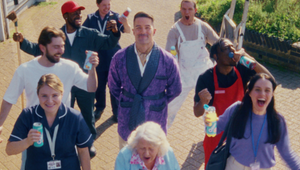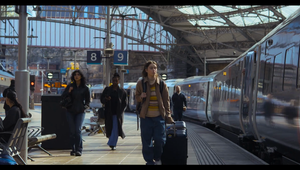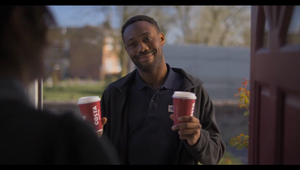
Could Embracing Neurodiversity Be a Catalyst for Innovative Marketing?

Hogarth’s content production strategy director, Charlotte Crewe, advocates for the recognition and celebration of neurodiversity in the workplace
I’ve lost count of the number of times I’ve seen the word ‘innovation’ splashed across pitch decks, reels, websites, articles and the likes – suffice to say everyone wants to do innovation and be known for it. But what if there was a hack?
The very thing that ‘makes innovation, innovation’ is doing different. To do different, you must first think different. If diversity of thought is the secret sauce, why aren’t we bringing more neurodiverse perspectives to the table?
At the heart of innovation is the ability to think, and act, differently to the norm. No one slaps the innovation sticker on something they’ve seen or done time and time again.
Behind every innovation, lies a person, or several persons, who had the ability to think and act differently. If we seek innovation, we should therefore seek those individuals that do just that. Think differently. Act differently. See the world, and interact with it, differently. What do Henry Ford, Billie Eilish, Steve Jobs and Tim Burton have in common? They are among their industry’s greatest innovators – and they all are neurodivergent. Many use neurodiversity as an umbrella term to describe alternative thinking styles such as ADHD, Autism, Dyslexia, DCD (Dyspraxia) and Dyscalculia. But if we shelve labels for a sec, neurodiversity is about recognising those who think differently. So, what would happen if the industry viewed neurodiversity, not merely as an exercise in DEI, but as a catalyst for creativity and innovation?
In recent years we’ve seen a shift from ‘awareness’ weeks, to other more progressive weeks including Neurodiversity Celebration Week and Autism Acceptance Week. We’re seeing a positive shift from awareness, and tolerance, towards acceptance and celebration. It’s time that agencies jump on the proverbial bandwagon and begin to celebrate neurodiversity, the perspectives, creativity and solutions-driven attributes it can bring and importantly, the innovation that can be born out of diversity of thought across our industry.
Those with neurodivergent traits can often have an exceptional ability to think outside traditional frameworks, offering novel insights and unconventional solutions to complex challenges. Their different ways of processing information can lead to innovative problem-solving strategies, outside-the-box thinking and unique creativity that might differ from more neurotypical perspectives.
Last year, I was diagnosed with Autism and ADHD, commonly referred to as AuDHD (another acronym to add to our industry’s arsenal!) and have since begun to appreciate and celebrate the way that I relate to the world. I am proud of my neurodivergent brain and I’m proud of the achievements I’ve made throughout my career both in spite of, and because of it.
I can now say with confidence, that I would not be in the position I am today without the qualities attributed to my uniquely AuDHD brain, or what I refer to as my neuro-spiciness (Nando’s, DM me for collab opportunities).
Every neurodivergent individual has a unique pattern of strengths and challenges. My brain is wired in such a way that I struggle to filter out background sounds and can’t bear sitting still at a desk under halogen lighting, but I can also spot patterns, discover niches in the market and hyper-focus like a pro.
Diversity in the way we think can lead to diversity in the outcomes we produce. I recently founded an internship programme at Hogarth – The Originals – that turned traditional recruitment on its head. We sought raw creative talent through an anonymous, no CVs, no qualifications necessary approach that asked candidates to respond to the brief: “sell us a Lemon via TikTok.” It was hands-down the most entertaining, engaging and effective recruitment process I've ever experienced and at the end of the process we hired 6 incredibly talented, diverse content creators who have since worked on some of our biggest brands and are all now full-time employees at Hogarth.
Neurodiversity and innovation have a common intersection – in their diversity, in their uniqueness; everyone and everything under those umbrellas are considered different from the norm. Neurodiverse individuals already think and do different every day, sometimes without even realising it, so imagine if we could place that thinking in the context of creativity and marketing. If businesses open their minds and shift their perspective towards embracing neurodiversity, imagine the innovations they have the potential to unlock. The majority of the ‘challenges’ neurodivergent people face in the workplace are often more to do with the environment and systems they are placed in, usually designed by/for a neurotypical population.
Making adaptations to the office and championing flexible working are two ways that can help alleviate some of those challenges. And what's more, at Hogarth we’ve found that adapting key spaces, optimising them for neurodivergent individuals, is also benefiting our wider employee-base. I mean, let’s face it, few people actually enjoy sitting in an uncomfortable chair under buzzing lighting (if you haven’t already clocked it, I’m obsessed with lighting) whilst a cacophony of one-sided teams calls bombards you from all angles, 5 days a week.
My favourite space is the wellness room, equipped with soothing soundscapes, soft furnishings and the all-important variable lighting (and, if I have it my way, we’d add in a lava lamp, or two, for good measure).
We have also just launched a new employee support group that embraces and celebrates neurodiversity, disability and mental health: Access All Areas, and I’m excited to be leading the charge in creating a community, environment and culture that will celebrate, support and attract diverse talent across our business.
These may seem like minor or trivial changes to some, but to someone like me, making adaptations to the office environment, allowing flexible working and being part of a community can make all the difference in terms of energy levels, stress management and general well-being. By providing employees with environments that empower them to thrive, we’re catalysing ingenuity and actualising our employees’ potential.
Actively supporting and embracing neurodiversity through creating an inclusive environment - one with value and support at the centre -reinforces the message that innovation thrives not within the traditional frameworks of our industry, but in the unconventional spaces beyond and in-between. By championing neurodiversity, we could unlock untapped potential, whilst also fostering a culture of continuous improvement and adaptation. And in doing so, we not only enrich our talent pool but also position ourselves at the forefront of innovation in an ever-evolving marketplace.
The synergies between neurodiversity and innovation are a testament to the incredible potential that lies within diverse minds. Neurodiversity may not be a superpower, but it can be super powerful. As organisations increasingly recognise the value of the neurodivergent community and provide proper support for them to thrive in the workplace, they open the door to a new era of creativity, problem-solving, and ground-breaking ideas that propel them into a future where innovation knows no bounds.















